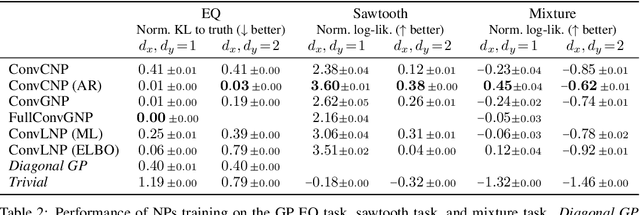Anthony Buonomo
Autoregressive Conditional Neural Processes
Mar 25, 2023



Abstract:Conditional neural processes (CNPs; Garnelo et al., 2018a) are attractive meta-learning models which produce well-calibrated predictions and are trainable via a simple maximum likelihood procedure. Although CNPs have many advantages, they are unable to model dependencies in their predictions. Various works propose solutions to this, but these come at the cost of either requiring approximate inference or being limited to Gaussian predictions. In this work, we instead propose to change how CNPs are deployed at test time, without any modifications to the model or training procedure. Instead of making predictions independently for every target point, we autoregressively define a joint predictive distribution using the chain rule of probability, taking inspiration from the neural autoregressive density estimator (NADE) literature. We show that this simple procedure allows factorised Gaussian CNPs to model highly dependent, non-Gaussian predictive distributions. Perhaps surprisingly, in an extensive range of tasks with synthetic and real data, we show that CNPs in autoregressive (AR) mode not only significantly outperform non-AR CNPs, but are also competitive with more sophisticated models that are significantly more computationally expensive and challenging to train. This performance is remarkable given that AR CNPs are not trained to model joint dependencies. Our work provides an example of how ideas from neural distribution estimation can benefit neural processes, and motivates research into the AR deployment of other neural process models.
Determining Research Priorities for Astronomy Using Machine Learning
Mar 01, 2022Abstract:We summarize the first exploratory investigation into whether Machine Learning techniques can augment science strategic planning. We find that an approach based on Latent Dirichlet Allocation using abstracts drawn from high impact astronomy journals may provide a leading indicator of future interest in a research topic. We show two topic metrics that correlate well with the high-priority research areas identified by the 2010 National Academies' Astronomy and Astrophysics Decadal Survey science frontier panels. One metric is based on a sum of the fractional contribution to each topic by all scientific papers ("counts") while the other is the Compound Annual Growth Rate of these counts. These same metrics also show the same degree of correlation with the whitepapers submitted to the same Decadal Survey. Our results suggest that the Decadal Survey may under-emphasize fast growing research. A preliminary version of our work was presented by Thronson et al. 2021.
 Add to Chrome
Add to Chrome Add to Firefox
Add to Firefox Add to Edge
Add to Edge